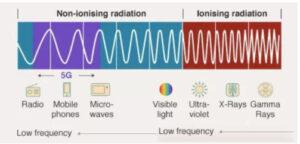The working frequency of 5G is much higher than 4G, which forces PCB designers to reconsider their board design and manufacturing methods.
With the arrival of 5G, electrical engineers must reconsider (sometimes redesign) their PCBs and other infrastructure to support the high frequencies of the new spectrum.
Signal integrity will become the primary issue in the design of 5G PCB boards.

In this article, let’s take a look at the impact of higher frequencies on PCB signal integrity and ways to alleviate these issues.
Why is 5G frequency detrimental to signal integrity?
In circuit board design, an increase in frequency can have many adverse effects on signal integrity, especially increasing noise and attenuation.
1.noise
Regarding noise, the first thing to consider is that as the system frequency increases, signal reflection becomes increasingly important. According to transmission line theory, reflection is directly related to the ratio of transmission line length to signal wavelength.
2.Signal reflection
We also know that the signal wavelength decreases with increasing frequency( λ= V/f).
Therefore, as 5G introduces higher frequencies, designers must also consider the impact of signal reflection
For example, ringing or other distortions can cause more noise in the system and effectively reduce SNR.
3.Coupling of capacitance and inductance
In addition, due to the correlation between capacitance and inductance with the rate of change of voltage and current, the effects of capacitance coupling and inductance coupling become more relevant. This also generates noise and distortion, thereby reducing SNR.
4.Attenuation and skin effect
An important factor to consider regarding attenuation is the so-called skin effect. Essentially, it indicates that as the signal frequency increases, the penetration depth of the signal inside the conductor will decrease.
5.Skin effect
The important meaning of skin effect is that as higher frequencies pass through smaller regions, they will encounter greater resistance and cause greater IR loss. This kind of loss will also reduce SNR.
Methods to improve SNR in 5G design
In high-speed design, there are many factors that can affect the integrity of the signal. So, what can designers of 5G PCB boards do?
Control circuit board impedance
The important step in reducing signal reflection and attenuation is to control the impedance of the circuit board. Having appropriately terminated circuits and carefully designed impedance matching networks are crucial for preventing signal reflection and providing maximum power to circuit modules.
Focusing on Impedance in Manufacturing: mSAP
Impedance control issues can also be solved when manufacturing circuit boards.
The traditional PCB manufacturing process has the disadvantage of creating wiring with trapezoidal cross-sections. These cross-sections will alter the impedance of the wiring itself, severely limiting 5G applications.
One solution is to use mSAP (Semi additive Manufacturing Process) technology, which enables manufacturers to create wiring with higher accuracy. The geometric shape of the control circuit can also help reduce skin effect and signal power loss caused by it.
Placing components and wiring
The most important thing in mitigating effects such as coupling is to wisely connect components and wiring relative to each other and ground them.
For example, multi-layer PCBs with buried grounding layers and power supply planes may be a useful solution.
Placing sensitive lines near the ground plane will force capacitive coupling with the ground (opposite to other lines) and provide a low inductance return path for high-speed signals.
More considerations for 5G design
Although this article does not provide a comprehensive list of all issues or solutions addressed, we have reviewed some advanced issues related to signal integrity in 5G frequency and possible design solutions to address these issues.
Obviously, 5G will bring signal integrity challenges to PCB engineers, as the frequency dependent effects of noise and attenuation will reduce SNR.
For successful 5G design, some factors not considered in this article, such as the selection of dielectric and substrate materials, are equally important.
